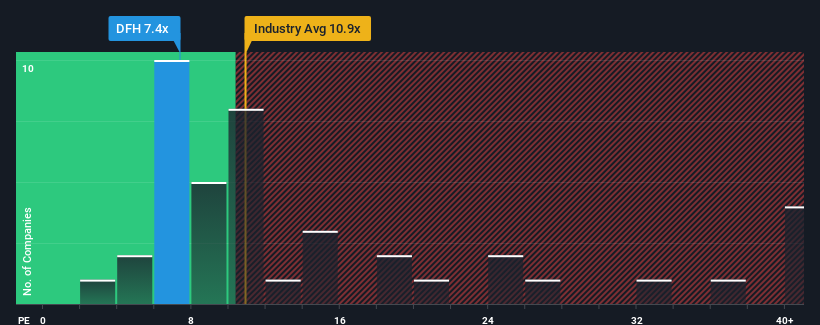- United States
- /
- Consumer Durables
- /
- NYSE:DFH
The Market Doesn't Like What It Sees From Dream Finders Homes, Inc.'s (NYSE:DFH) Earnings Yet As Shares Tumble 30%

Dream Finders Homes, Inc. (NYSE:DFH) shareholders that were waiting for something to happen have been dealt a blow with a 30% share price drop in the last month. Instead of being rewarded, shareholders who have already held through the last twelve months are now sitting on a 35% share price drop.
In spite of the heavy fall in price, Dream Finders Homes' price-to-earnings (or "P/E") ratio of 7.4x might still make it look like a strong buy right now compared to the market in the United States, where around half of the companies have P/E ratios above 19x and even P/E's above 34x are quite common. Although, it's not wise to just take the P/E at face value as there may be an explanation why it's so limited.
Recent times have been advantageous for Dream Finders Homes as its earnings have been rising faster than most other companies. One possibility is that the P/E is low because investors think this strong earnings performance might be less impressive moving forward. If you like the company, you'd be hoping this isn't the case so that you could potentially pick up some stock while it's out of favour.
See our latest analysis for Dream Finders Homes

Does Growth Match The Low P/E?
There's an inherent assumption that a company should far underperform the market for P/E ratios like Dream Finders Homes' to be considered reasonable.
If we review the last year of earnings growth, the company posted a worthy increase of 10%. The latest three year period has also seen an excellent 114% overall rise in EPS, aided somewhat by its short-term performance. Accordingly, shareholders would have probably welcomed those medium-term rates of earnings growth.
Turning to the outlook, the next year should generate growth of 4.8% as estimated by the three analysts watching the company. Meanwhile, the rest of the market is forecast to expand by 15%, which is noticeably more attractive.
With this information, we can see why Dream Finders Homes is trading at a P/E lower than the market. Apparently many shareholders weren't comfortable holding on while the company is potentially eyeing a less prosperous future.
What We Can Learn From Dream Finders Homes' P/E?
Having almost fallen off a cliff, Dream Finders Homes' share price has pulled its P/E way down as well. We'd say the price-to-earnings ratio's power isn't primarily as a valuation instrument but rather to gauge current investor sentiment and future expectations.
As we suspected, our examination of Dream Finders Homes' analyst forecasts revealed that its inferior earnings outlook is contributing to its low P/E. At this stage investors feel the potential for an improvement in earnings isn't great enough to justify a higher P/E ratio. It's hard to see the share price rising strongly in the near future under these circumstances.
It is also worth noting that we have found 3 warning signs for Dream Finders Homes (2 can't be ignored!) that you need to take into consideration.
If P/E ratios interest you, you may wish to see this free collection of other companies with strong earnings growth and low P/E ratios.
New: Manage All Your Stock Portfolios in One Place
We've created the ultimate portfolio companion for stock investors, and it's free.
• Connect an unlimited number of Portfolios and see your total in one currency
• Be alerted to new Warning Signs or Risks via email or mobile
• Track the Fair Value of your stocks
Have feedback on this article? Concerned about the content? Get in touch with us directly. Alternatively, email editorial-team (at) simplywallst.com.
This article by Simply Wall St is general in nature. We provide commentary based on historical data and analyst forecasts only using an unbiased methodology and our articles are not intended to be financial advice. It does not constitute a recommendation to buy or sell any stock, and does not take account of your objectives, or your financial situation. We aim to bring you long-term focused analysis driven by fundamental data. Note that our analysis may not factor in the latest price-sensitive company announcements or qualitative material. Simply Wall St has no position in any stocks mentioned.
About NYSE:DFH
Dream Finders Homes
Operates as a holding company for Dream Finders Homes LLC that engages in homebuilding business in the United States.
Adequate balance sheet and fair value.
Similar Companies
Market Insights
Community Narratives



